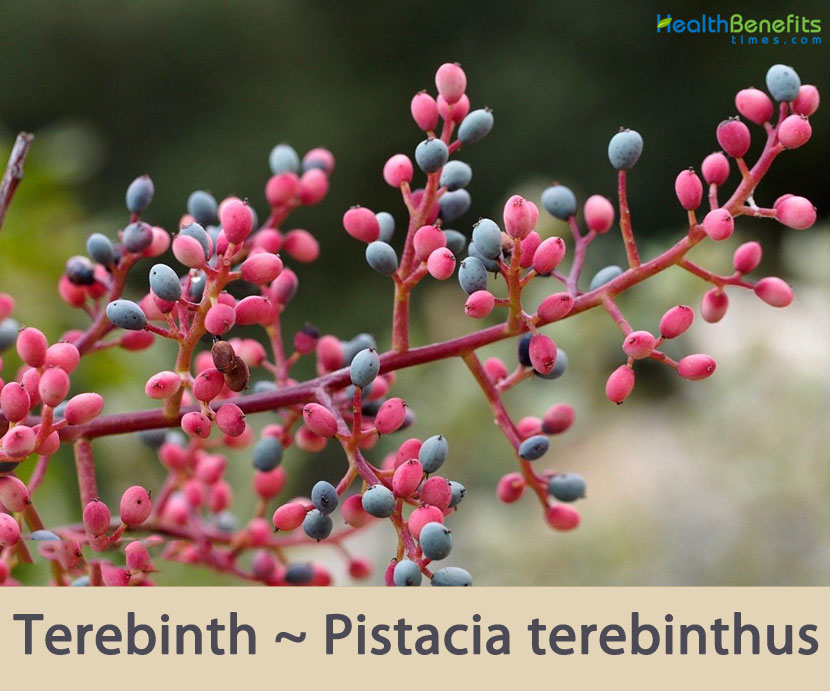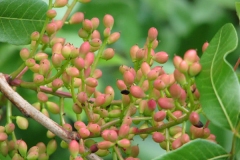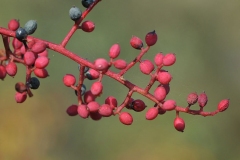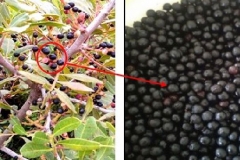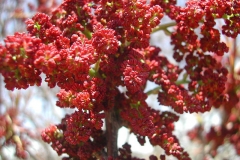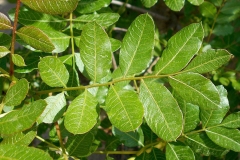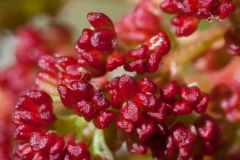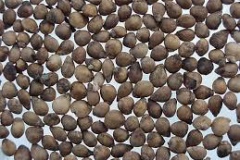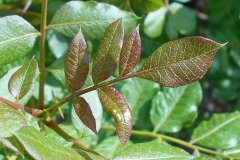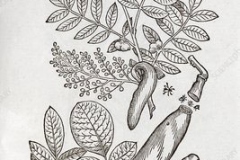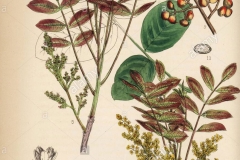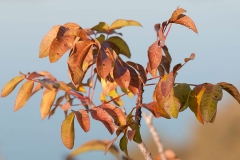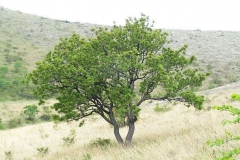| Terebinth Quick Facts | |
|---|---|
| Name: | Terebinth |
| Scientific Name: | Pistacia terebinthus |
| Origin | Canary Islands, and the Mediterranean region from the western regions of Morocco and Portugal to Greece and western and southeastern Turkey |
| Colors | Red to black when ripe |
| Shapes | Single-seed spherical drupe about 5–7 mm (0.20–0.28 in) long |
| Flesh colors | Green pulp |
| Health benefits | Treat wounds, arthritis, gout, leprosy, scabies, lice, sciatica, hemorrhage, gallstones, tapeworm and rheumatism |
| Name | Terebinth |
|---|---|
| Scientific Name | Pistacia terebinthus |
| Native | Canary Islands, and the Mediterranean region from the western regions of Morocco and Portugal to Greece and western and southeastern Turkey. At one time terebinth is found growing on the eastern shores of the Mediterranean Sea (in Syria, Lebanon, Israel and the Palestinian territories) |
| Common Names | Tourist tree, Cyprus turpentine, Cyprus Turpentine, Terebinth, Turpentine tree, Cyprus turpentine tree, Terebinth tree, Eastern Turpentine Tree, terebinth pistachio |
| Name in Other Languages | Albanian: Bafër, xinë Arabic: Ealak al’anbat (علك الأنباط) , khadra’ haba (خضراء حبة), batm filastiniin (بطم فلسطيني), butm tirbantini (بطم تربنتيني) Azerbaijani: Terebint püstəsi Basque: Ahuntzadar Bulgarian: Kukuch (кукуч) Catalan: Cornicabra, garrofer bord, noguerola, smrdljika, terebint Chinese: Dǔ nòu huánglián mù (篤耨黃連木) Croatian: Smrdljika Czech: Rečík terebintový Danish: Terpentinbusk, Terpentintræ Dutch: Terpentijnboom English: Cyprus turpentine, Cyprus turpentine tree, Terebinth, Terebinth tree, Turpentine tree, Eastern Turpentine Tree, terebinth pistachio Esperanto: Terebintarbo Finnish: Tärpättipistaasi French: Pistachier térébinthe, Térébinthe, pudis, Galician: Terebinto German: Terebinthe, Terpentin-Pistazie, Östlicher Terpentinstrauch, Pistazienbaum, Terpentinbaum, Terpentinpistazie, Terpentinpistazienstrauch Greek: Terévinthos (Τερέβινθος) Hebrew: אלה ארצישראלית, אלת טרבינת Ido: Terebinto Irish: Tuirpintín Italian: Como, Terebinto, Corno, cornucopia, scornabecco, spaccasasso Japanese: Terebin’noki (テレビンノキ) Kabyle: Hejji Kurdish: Kezwan Macedonian: Smrdlika (смрдлика) Norwegian: Terpentintre Occitan: Petelin Persian: پسته کوهی Polish: Pistacja terpentynowa Portuguese: Comalheira, Terebinto, Scornabecco Russian: Terpentinnoye derevo (терпентинное дерево) Serbian: Smrdljika (смрдљика), terpentin-drvo (терпентин-дрво) Shambala: Smrdljika Slovenian: Listopadna pistacija, Smrdljika, terebint Spanish: Cabracoja, Cornicabra, Escuernacabras, Escornacabra, Escornacabras, Terebinto, Tornalobo, Cornicabra terebinto, cabricuerno Swedish: Terpentinträd, Terebint Tunisian Arabic: Bitum (بطوم) Turkish: Menengiç Ukrainian: Terpentinne derevo (Терпентинне дерево) Upper Sorbian: Terpentinowa pistacija |
| Plant Growth Habit | Small flowering, deciduous tree or large shrub |
| Growing Climates | Dry open woods, scrub, dry rock slopes, hillsides areas, pine forest, and maquis vegetation |
| Soil | Grows best in a sandy to stony alkaline soil |
| Plant Size | 2 – 6 meters tall, occasionally reaching 12 meters |
| Bark | Greyish or brown and cracks with age |
| Leaf | Compound, 10–20 cm (3.9–7.9 in) long, odd pinnate with five to eleven opposite glossy oval leaflets, the leaflets 2–6 cm (0.79–2.36 in) long and 1–3 cm (0.39–1.18 in) broad |
| Flowering season | March and April |
| Flower | The female flowers have 2-5 sepals and no corolla. The pistil is short and cleft at its stigma. The ovary is superior. The male flowers have a sepal with 3-5 lobes, and they too do not have a corolla. |
| Fruit Shape & Size | Single-seed spherical drupe about 5–7 mm (0.20–0.28 in) long |
| Fruit Color | Red to black when ripe |
| Flesh Color | Green pulp |
| Propagation | By seeds, semi woody cuttings or air layering |
| Flavor/Aroma | Strong resinous smell |
| Plant Parts Used | Bark, Resin, leaves |
| Season | August and September |
Plant Description
Terebinth is a small flowering, deciduous tree or large shrub that normally grows about 2 – 6 meters tall, occasionally reaching 12 meters. The plant is found growing in dry open woods, scrub, dry rock slopes, hillsides areas, pine forest, and maquis vegetation. The plant grows best in a sandy to stony alkaline soil. Its bark is greyish or brown and cracks with age
Leaves
The oblong leaf is bright green, leathery, pinnate, its leaflets are sessile, limp, glabrous, and end in a long point. Each leaf has 4-6 pairs of leaflets, and usually another non-paired smaller leaflet at the tip of the leaf. The upper side of the leaflet is not shiny, the margin of the leaflets is entire. The axis of the leaf is cylindrical, without a margin. The leaves are alternate. In the winter the tree can be recognized by its large and pilose buds. They are generally larger and rounder than the leaves of the mastic, reminiscent of the leaves of carob tree.
Flowers
Terebinth blooms in the months of March-April. The inflorescence is a panicle with dense racemes of tiny flowers. The female flowers have 2-5 sepals and no corolla. The pistil is short and cleft at its stigma. The ovary is superior. The male flowers have a sepal with 3-5 lobes, and they too do not have a corolla. They have 3-7 stamens with short filaments. The stamens and the stigmas are red, and give the inflorescence its red color.
Fruit
Fertile flowers are followed by single-seed spherical drupe with a diameter of 5 mm and a green pulp. Upon ripening it turns red to purple-blue. The red fruits are sterile. The fruits are edible. Their seeds are dispersed by birds. They appear in large groups which acquire a very eye-catching pink color when they ripen.
Generally, terebinth fruits are used in traditional medicine for the treatment of various diseases including cough, eczema, asthma, diarrhea, ulcers and arthritis. They are also, used in cookies, additives for bread making and preparation of various foods such as cooking oil. Moreover, fruits are evaluated as a raw material for making bıttım and turpentine soap and also used in the production of different seasonings and spices. Also, terebinth fruits are processed roasting the terebinth coffee that has an extremely attractive color and smell. This coffee is one of the most consumed traditional coffees in Turkey and is generally cooked in milk.
Traditional uses and benefits of Terebinth
- Resin obtained from incisions in the bark is antidote, anti-inflammatory, antiseptic, antispasmodic, aphrodisiac, cytostatic, diuretic, expectorant, febrifuge, laxative, stimulant and vulnerary.
- Externally, the resin is used to treat wounds, arthritis, gout, skin conditions including leprosy, scabies and lice; sciatica.
- It is taken internally in the treatment of asthma and chronic bronchial infections, streptococcal, urinary and renal infections, hemorrhage, gallstones, tapeworm and rheumatism.
- It has also been used in the treatment of cancer.
- Resin is used for the treatment of Gout.
- Leaves of the plant are used as tea medicinally.
- The bark is an Antidote to rashes caused by Chechen Tree.
- It reduces Inflammation and relieves pain.
- It increases Libido in men and women.
- It helps in stops bleeding.
- It increases urination.
- They are used in the treatment of colds and flu, problems in the digestive system.
- It is also quite beneficial for liver, kidney, heart, and respiratory system disorders.
- The leaves are astringent, diuretic and hypotensive.
- They are used in the treatment of diabetes, stomach aches, diarrhea and jaundice.
- Terebinth primarily works on the mucus membranes of the kidneys and the urinary bladder.
- Homeopathic physicians usually prescribe this medication for treating tenderness and swelling of the kidneys and the urethra.
- It is also used to treat cystitis (inflammation of the urinary bladder) accompanied by fierce burning and drawing pains in the bladder, urethra and/ or the kidneys alongside unclear or dark urine that has a sweet odor.
Culinary Uses
- Seed can be consumed raw or cooked.
- It is sweeter and oilier than an almond.
- Edible oil is obtained from the seed.
- Immature fruits, including the stems, are preserved in vinegar and salt.
- Known as ‘atsjaar’, they are used as a relish to accompany wines served during meals.
- Young leaves can be cooked and used as a vegetable.
- Resin from the trunk is used as a vegetable and as a chewing gum.
- The fruits are used in Cyprus for baking of specialty village bread.
- In Crete, where the plant is called tsikoudia, it is used to flavor the local variety of pomace brandy, also called tsikoudia.
- In the Northern Sporades the shoots are used as a vegetable (called tsitsíravla).
- A coffee-like drink is made from the fruit.
Other Facts
- Resin is mainly used medicinally in the treatment of cancer and also as a chewing gum.
- The plant can be used as a rootstock for the pistachio nut, P. vera.
- The plant is a source of tannin.
- The whole plant emits a strong smell: bitter, resinous, or medicinal.
- Mild sweet scented gum can be produced from the bark, and galls often found on the plant are used for tanning leather.
- Red dye is obtained from galls that are formed on the leaves as a result of aphid infestation.
- The brown wood is very attractive. It can be used for carpentry and cabinet making.
References:
https://npgsweb.ars-grin.gov/gringlobal/taxon/taxonomydetail?id=28653
https://pfaf.org/user/Plant.aspx?LatinName=Pistacia+terebinthus
http://www.theplantlist.org/tpl1.1/record/kew-2407017
https://en.wikipedia.org/wiki/Terebinth
https://plants.usda.gov/home/plantProfile?symbol=PITE10
https://gd.eppo.int/taxon/PIATE
http://temperate.theferns.info/plant/Pistacia+terebinthus
https://www.cabi.org/isc/datasheet/41032


